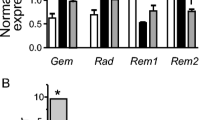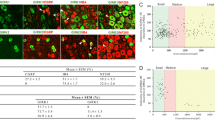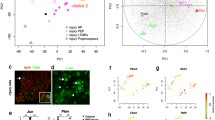Abstract
Objective
A calcium-activated chloride current (I Cl(Ca)) has been observed in medium-sized sensory neurons of the dorsal root ganglion (DRG). Axotomy of the sciatic nerve induces a similar current in the majority of medium and large diameter neurons. Our aim is to identify the molecule(s) underlying this current.
Methods
Using conventional and quantitative RT-PCR, we examined the expression in DRG of members of three families of genes, which have been shown to have I Cl(Ca) current inducing properties.
Results
We showed the detection of transcripts representing several members of these families, i.e. chloride channel calcium-activated (CLCA), Bestrophin and Tweety gene families in adult DRG, in the normal state and 3 d after sciatic nerve section, a model for peripheral nerve injury.
Conclusion
Our analysis revealed that that mBest1 and Tweety2 appear as the best candidates to play a role in the injury-induced I Cl(Ca) in DRG neurons.
摘要
目的
在背根神经节 (dorsal root ganglion, DRG) 中等大小感觉神经元中可以观察到钙激活氯离子流 (I Cl(Ca))。 在坐骨神经损伤模型中, 在大多数大中神经元上诱导出类似的氯离子流。 本文旨在探讨引起这个离子流的分子基础。
方法
使用常规的定量 RT-PCR 方法检测在 DRG 中三个基因家族的表达, 这三个基因家族都具有诱导 I Cl(Ca) 的特点。
结果
在成年小鼠的DRG中, 分别显示了在正常状态和坐骨神经损伤3天后 CLCA, Bestrophin 和Tweety基因家族成员的转录产物。
结论
MBestl和Tweety2可能在损伤诱导的DRG神经元I Cl(Ca)中发挥作用。
Similar content being viewed by others
References
Andre S, Boukhaddaoui H, Campo B, Al-Jumaily M, Mayeux V, Greuet D, et al. Axotomy-induced expression of calciumactivated chloride current in subpopulations of mouse dorsal root ganglion neurons. J Neurophysiol 2003, 90: 3764–3773.
Campbell HD, Kamei M, Claudianos C, Woollatt E, Sutherland GR, Suzuki Y, et al. Human and mouse homologues of the Drosophila melanogaster tweety (tty) gene: a novel gene family encoding predicted transmembrane proteins. Genomics 2000, 68: 89–92.
Chien LT, Zhang ZR, Hartzell HC. Single Cl-channels activated by Ca2+ in Drosophila S2 cells are mediated by bestrophins. J Gen Physiol 2006, 128: 247–259.
Frings S, Reuter D, Kleene SJ. Neuronal Ca2+-activated Cl-channels—homing in on an elusive channel species. Prog Neurobiol 2000, 60: 247–289.
Fuller CM, Ji HL, Tousson A, Elble RC, Pauli BU, Benos DJ. Ca (2+)-activated Cl(−) channels: a newly emerging anion transport family. Pflugers Arch 2001, 443Suppl 1: S107–S110.
Gibson A, Lewis AP, Affleck K, Aitken AJ, Meldrum E, Thompson N. hCLCA1 and mCLCA3 are secreted non-integral membrane proteins and therefore are not ion channels. J Biol Chem 2005, 280: 27205–27212.
Greenwood IA, Leblanc N. Overlapping pharmacology of Ca2+-activated Cl-and K+ channels. Trends Pharmacol Sci 2007, 28: 1–5.
Gruber AD, Elble RC, Pauli BU. Discovery and cloning of the CLCA gene family. In: Fuller CM Ed. Current topics in Membranes. London: Academic Press, 2002, 53: 367–387.
Hartzell C, Putzier I, Arreola J. Calcium-activated chloride channels. Annu Rev Physiol 2005, 67: 719–758.
Thompson JD, Higgins DG, Gibson TJ. CLUSTAL W: improving the sensitivity of progressive multiple sequence alignment through sequence weighting, position-specific gap penalties and weight matrix choice. Nucleic Acids Res 1994, 22: 4673–4680.
Hilaire C, Inquimbert P, Al-Jumaily M, Greuet D, Valmier J, Scamps F. Calcium dependence of axotomized sensory neurons excitability. Neurosci Lett 2005, 380: 330–334.
Hoebeeck J, van der Luijt R, Poppe B, De Smet E, Yigit N, Claes K, et al. Rapid detection of VHL exon deletions using real-time quantitative PCR. Lab Invest 2005, 85: 24–33.
Jentsch TJ, Stein V, Weinreich F, Zdebik AA. Molecular structure and physiological function of chloride channels. Physiol Rev 2002, 82: 503–568.
Kramer F, Stohr H, Weber BH. Cloning and characterization of the murine Vmd2 RFP-TM gene family. Cytogenet Genome Res 2004, 105: 107–114.
Leverkoehne I, Horstmeier BA, von Samson-Himmelstjerna G, Scholte BJ, Gruber AD. Real-time RT-PCR quantitation of mCLCA1 and mCLCA2 reveals differentially regulated expression in pre-and postnatal murine tissues. Histochem Cell Biol 2002, 118: 11–17.
Loewen ME, Forsyth GW. Structure and function of CLCA proteins. Physiol Rev 2005, 85: 1061–1092.
Marmorstein AD, Marmorstein LY, Rayborn M, Wang X, Hollyfield JG, Petrukhin K. Bestrophin, the product of the Best vitelliform macular dystrophy gene (VMD2), localizes to the basolateral plasma membrane of the retinal pigment epithelium. Proc Natl Acad Sci U S A 2000, 97: 12758–12763.
Matthews CA, Shaw JE, Hooper JA, Young IG, Crouch MF, Campbell HD. Expression and evolution of the mammalian brain gene Ttyh1. J Neurochem 2007, 100: 693–707.
Mechaly I, Bourane S, Piquemal D, Al-Jumaily M, Ventéo S, Puech S, et al. Gene profiling during development and after a peripheral nerve traumatism reveals genes specifically induced by injury in dorsal root ganglia. Mol Cell Neurosci 2006, 32: 217–229.
Mundhenk L, Alfalah M, Elble RC, Pauli BU, Naim HY, Gruber AD. Both cleavage products of the mCLCA3 protein are secreted soluble proteins. J Biol Chem 2006, 281: 30072–30080.
Needleman SB, Wunsch CD. A general method applicable to the search for similarities in the amino acid sequence of two proteins. J Mol Biol 1970, 48: 443–453.
Ritzka M, Weinel C, Stanke F, Tummler B. Sequence comparison of the whole murine and human CLCA locus reveals conserved synteny between both species. Genome Lett 2003, 2: 149–154.
Suzuki M, Mizuno A. A novel human Cl(-) channel family related to Drosophila flightless locus. J Biol Chem 2004, 279: 22461–22468.
Suzuki M. The Drosophila tweety family: molecular candidates for large-conductance Ca2+-activated Cl-channels. Exp Physiol 2006, 91: 141–147.
Vandesompele J, De Preter K, Pattyn F, Poppe B, Van Roy N, De Paepe A, et al. Accurate normalization of real-time quantitative RT-PCR data by geometric averaging of multiple internal control genes. Genome Biol 2002, 3: RESEARCH0034.
Whittaker CA, Hynes RO. Distribution and evolution of von Willebrand/integrin A domains: widely dispersed domains with roles in cell adhesion and elsewhere. Mol Biol Cell 2002, 13: 3369–3387.
Yu K, Cui Y, Hartzell HC. The bestrophin mutation A243V, linked to adult-onset vitelliform macular dystrophy, impairs its chloride channel function. Invest Ophthalmol Vis Sci 2006, 47: 4956–4961.
Author information
Authors and Affiliations
Corresponding author
Rights and permissions
About this article
Cite this article
Al-Jumaily, M., Kozlenkov, A., Mechaly, I. et al. Expression of three distinct families of calcium-activated chloride channel genes in the mouse dorsal root ganglion. Neurosci. Bull. 23, 293–299 (2007). https://doi.org/10.1007/s12264-007-0044-8
Received:
Published:
Issue Date:
DOI: https://doi.org/10.1007/s12264-007-0044-8




